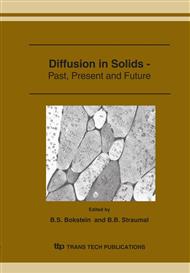p.193
p.201
p.213
p.219
p.227
p.231
p.235
p.239
p.247
Role of Diffusion as a Control Stage of a Grain Boundary Liquid Grooving
Abstract:
The interaction of liquid metals with solid polycrystalline metal leads to the appearance of liquid grooves at grain boundaries. The shapes of these grooves may be of a very wide variety. In this paper the typical features of different liquid grooves are presented, classified and analyzed on the base of our experimental data. The developed models confirm the dominant role of diffusion mechanisms.
Info:
Periodical:
Pages:
227-230
Citation:
Online since:
January 2006
Authors:
Keywords:
Price:
Сopyright:
© 2006 Trans Tech Publications Ltd. All Rights Reserved
Share:
Citation:


